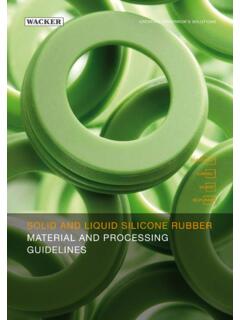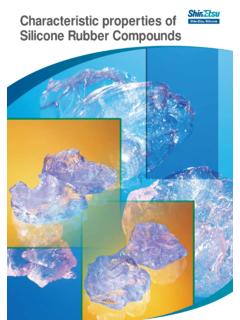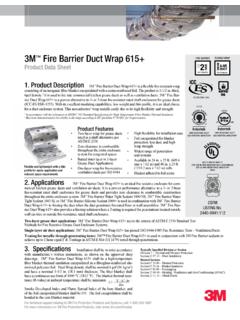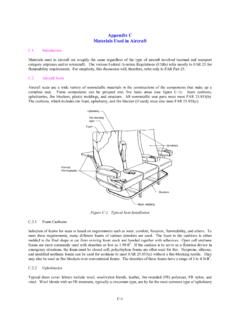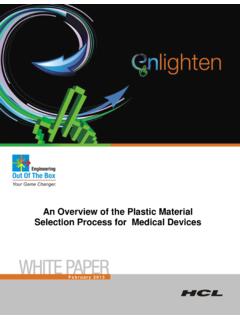Transcription of Silicones - Compunds and Properties - Wacker Chemie
1 Creating tomorrow s solutionselastomers, PlastiCs & ComPositessiliConesCompounds and PropertiessiliCones a world of unlimited PossibilitiesContentIntroduction 4 The Element Silicon 5 The Structure of Silicones 7 silicone Applications 10 Pyrogenic Silica 12 Organofunctional Silanes 13 silicone Fluids 14 silicone Release Agents 15 silicone Antifoam Agents 16 silicone Textile Finishes 17 silicone Rubber Compounds 18 silicone Masonry Protection Agents 22 silicone Resins 23 The History of Silicones 24 Silicones and Innovations 26 Science and Awards 28 Wacker at a Glance 31 ELASTOSIL and HDK are registered trademarks of Wacker Chemie are truly jacks of all trades, capable of standing up to the toughest of requirements. Modern life would be inconceivable without Silicones . And, thanks to the freedom for design-ing the silicone molecule, there are countless future applications still to encounter Silicones every day, though we hardly every notice them.
2 Under the hood, silicone rubber protects the car electronics against moisture and dirt; in car lacquers silicone additives provide gloss; in washing machines, silicone antifoam agents prevent the detergent from foaming over; in shampoo they give hair its sheen; they provide woolen gar-ments with a typical soft hand, and, as silicone resin emulsion paints, they give masonry water repellency, while allowing water vapor and carbon dioxide to dif-fuse out of its also perform superbly in medi-cal applications, where high resistance or a state-of-the-art product is required: as a highly pure material for medical tubes, plasters or orthopedic products, as a reliable sealant and insulating mate-rial in electrical equipment or insulators. Pyrogenic silica is also used as a thick-ening additive in adhesives for the rotor blades of wind outstanding versatility is the result of silicone chemistry: Silicones are modern synthetic products based on a raw material, quartz sand, which is avail-able in practically unlimited quantities.
3 Their versatile performance is due to the chemical structure and the many differ-ent ways it can be modified. As a result, Silicones can be provided with tailor-made Properties that are fascinating and offer continually new possibilities. On the following pages, let us guide you through the world of Silicones . Discover the unique chemical and physical prop-erties, and gain insights into the versatile applications they open Can be found eVerYwHere4from raw material to tHe ProduCt worldThe chemistry of silicon and its compounds is extremely dynamic. Hardly any technology in recent decades has shaped technical progress so strikingly as silicon chemistry. This success story begins with the element Facts In nature, silicon occurs exclusively in oxidized form, as the compounds silicon dioxide and silicates. Silicon is the second commonest element in the Earth s solid crust, accounting for percent by weight, and the most important compo-nent of inorganic materials.
4 Since silicon is very rarely found as an element in nature, it was not isolated until relatively recently. On the other hand, siliceous construction and engineering materials, such as sand, clay and ceramics, have been available since time Chemistry is Very EfficientIn 1940/41, Professors M ller and Rochow independently discovered how to react silicone with methyl chloride gas (CH3Cl) to form liquid methylchloro-silanes. This step provided the starting materials for the industrial manufacturing of Silicones and launched a global boom in silicone production. Based on the pio-neering work of Dr. Siegfried Nietzsche, Wacker , in 1947, became the first European company to start researching the field. In the following years, Wacker processes laid the cornerstone for the modern and efficient manufacturing of organochlorosilanes and silicone products. This was the beginning of the success story. These early scientific accomplish-ments underlie Wacker s reputation as the European pioneer of silicone chem-istry.
5 Now globally active, the Group uses complex chemical processes to manu-facture versatile product classes such as silicone fluids, resins or elastomer SilicatesPyrogenic SilicaSilicone Fluids and EmulsionsMasonry Protective AgentsAntifoamAgentPaper CoatingMaterialLiquis SiliconeRubber GradesRTV-2 RubbersRubber CompoundsPolymersResinsOrganofunctional SiloxanesOrganofunctional SilanesSilicone FluidsMold-Release AgentsTextile FinishesSilicone RubberCompoundsRTV-1 SealantsHydrolysisTetrachlorosilaneSilic onCrude Silane MixtureSilane DestillationM ller-Rochow MethodCoalElectric FurnaceSandMethylchlorosilanesReactorThe production scheme for Wacker silicones6 HigHlY fleXible elementarY building bloCKsSilicones, silanes and the various siloxane units a few words about terminology, classification and Term silicone The term silicone was coined by F. S. Kipping (1863-1949), and refers to the formal analogy between these silicon compounds and the equivalent oxygen compounds of carbon (poly-silicoketones).
6 However, the Si-O-Si group is better described by the term siloxane. Strictly speaking, therefore, all Silicones should correctly be termed polysiloxanes. Nowadays, the term silicone is principally used in conjunc-tion with the technical applications of polysiloxanes. Silanes are the Starting PointThe starting point and chief building blocks for silicone production are silanes. Silanes are produced by direct synthesis from silicon and methyl chloride (M ller Rochow synthesis). They are colorless, clear, mobile liquids that are soluble in organic solvents including anhydrous alcohol in certain cases. The low mole-cular mass of silanes makes them highly silicone StructureSilicones, known to chemists as polydio-rganosiloxanes, have a structure that resembles quartz modified with organic groups. They consist of an inorganic backbone built up of alternating silicon and oxygen atoms. The other two bonds of the silicon atoms are occupied with organic groups (preferably methyls), which are responsible for Silicones semi-organic figure illustrates the typical structure of a linear silicone polymer (polydimeth-ylsiloxane).
7 The nonpolar methyl groups can rotate freely around the silicon-oxygen chain, forming a shield for the polar main chain. The shielding explains the low surface tension and high spreading power that make Silicones ideally suited for use as efficient hydrophobizing chemists distinguish bet-ween four different structural units:Monofunctional units permit chain units form the backbone of macromolecular chains and ring units produce branched molecules and form the basis of units lead to crosslinked structures similar to Monofunctional unitsSiORRRSiORRSiOROOOSiOOOO Difunctional unitsSiORRRSiORRSiOROOOSiOOOO Trifunctional unitsSiORRRSiORRSiOROOOSiOOOO Tetrafunctional unitsstruCtural VarietY as a formula for suCCess8 SiOCH3CH3 SiSiSiSiOOOCH3CH3CH3CH3CH3CH3CH3CH3 OOSiClCH3CH3 ClOCH3CH3 SiOCH3 OSiOCH3 OSiCH3CH3 SiCH3 SiCH3CH3CH3 OChemical structure of a linear silicone polymer (polydimethylsiloxane)SiCH3CH3 ClClChemical structure of a silane (dimethyldichlorosilane)From Semi-Organic PlasticsSilicones are a special group of plastics.
8 The term plastic is normally used to refer to organic materials that do not occur in nature. Silicones are classed as semi-organic materials since the element silicon has a strong metallic character compared to StableThe Si-O bond energy is significantly greater than that of a C-C bond. This has far-reaching effects on the stability and resistance of Silicones to a variety of influences. For example, Silicones have remarkable thermal and thermooxidative resistance. Silicones are also far less readily attacked by electromagnetic and particle radiation (UV, alpha, beta and gamma rays) than organic FormulasSilicones chemical structure allows them to be produced in a number of variations. By using siloxane units with different valences, products can be made with oily, polymeric, resinous or crosslinked Properties . At the same time, the organic groups bound to the silicon pave the way for a diverse range of modifications. It is this variability that makes possible the impressive variety of silicone products: greases, release agents, antifoam agents, paint additives, paper coatings, hydrophobizing agents, high or room-temperature vulcanizing silicone rubbers, and many, many more.
9 910 Life ScienceConstructionCoatings & AdhesivesPaper, Film Coatings & NIP Release papers Release liners Films Fuser oils Rolls/belts Toner s Printing inks Agrochemicals Food industry Organic synthesis Pharmaceutical products Antiflatulence and antacid preparations Transfusion, infusion and dialysis tubes Respirator bellows Prosthetics Dental impression compounds Extremely heat- resistant coatings / tubular radiators Corrosion protection Coil coating Cable insulation and sheathing Filter and clean-room technology Equipment engineering Household appliances irons, cookers Glass jugs Glass/glass-reinforced laminates Mica impregnation Electromagnets Lighting technologyEnergy, Electrics & Electronics Composite insulators Insulator coatings Cable accessories Transformers Semiconductor industry Consumer and power electronics Photovoltaics Measuring instruments Textiles, Leather & FibersChemical Industry Plasticizers and elastomers Water-repellent treatment Fine coating Fiberfill finishing Fiber preparation Sewing thread lubricants Defoaming Wastewater Petroleum industry Slags Welding filler materials Tire release agentsAutomotive & Transport FIPG and CIPG (formed- and cured-in-place gaskets) Cylinder-head gaskets Radiators Viscous clutches Headlamps Air filters Vibration dampers Airbags Automotive electronics Aerospace Shipbuilding and trains Colorless water-repellent treatment of facades and concrete Impregnation of traffic-bearing structures (bridges and parking decks)
10 Binders for silicone resin emulsion paints Natural stone conservation (strengthening and hydrophobization) Joint sealants Gasket profiles Jointing tapesElastomers, Plastics & CompositesConsumer Care Hair care Skin care Deodorants Color cosmetics Oral hygiene Detergents and cleaning agents Molded articles Extruded articles Injection molded articles Composites Cable manufacture and sheathing Moldmaking Pad printing Plastics additives Impregnating agents Polyethylene curing Precision castingSiliconesWACKER Silicones the Basis of Unlimited Applications11 PYrogeniC siliCaChemical Structure and PropertiesPyrogenic silica consists of SiO4/2 tetra- hedra, each of which is linked to adjacent tetrahedra by means of a common oxygen atom. Pyrogenic silica is pro-duced at temperatures over 1,000 C by introducing volatile chlorosilane into an oxyhydrogen flame. The primary particles have a smooth, non-micro-porous surface of about 5 to 30 nm.
